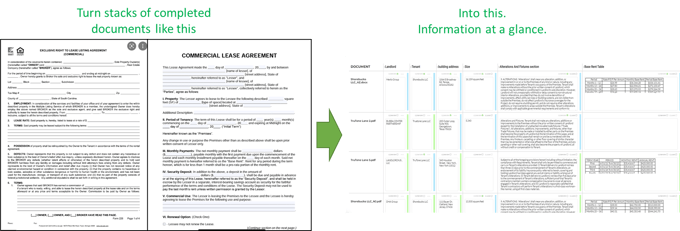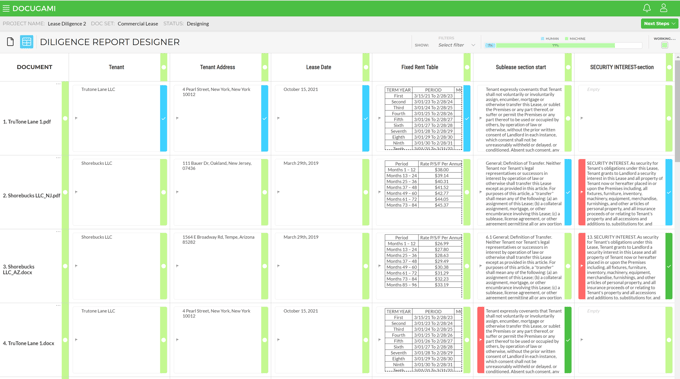Generative AI for the Transaction Diligence Process | AI Due Diligence
Can Generative AI Help with Due Diligence?
Today, Generative AI is primarily known as a way to produce content based on information gathered from the Internet. The diligence process involves discovering important information about the parties in the pursuit of a deal or transaction for a company, a property, or other assets.
While an internet search can perhaps surface some relevant, generic information, there is much more information within a deal that is confidential and private to the parties involved.
With that in mind, can the concept of generative AI help during the diligence process of a deal?
Artificial intelligence and machine learning have been used for awhile now to complement and enhance due diligence when executing a deal. AI can be programmed and applied to go through a wealth of information, quickly, efficiently, and accurately, allowing people to avoid the tedium of going through mountains of information manually.
That said, it may involve significant setup time, and require that the information be structured to enable the AI to do its thing.
Generative AI is known for people being able to simply go to a computer screen and type in questions, avoiding the typical AI complexity.
So how can this ‘new’ breed of AI in the news today apply, or assist in the diligence process? This National Law Review article goes through some of the pros and cons of considering an approach with generative AI and points to its potential in general for legal reviews, with a caution: “...if the pitfalls and concerns are addressed first and the responsible development of generative AI tools is put at front and center.”
The Diligence Process Is About Discovering Important, Often Private Information
There may be a great deal of information publicly available about a company, a property, a project, or an asset to be acquired. Indeed, it’s often publicly available information that drives interest in a deal! But during the evaluation period, once terms are discussed, it’s the private information that becomes the center of attention. This information may be in financial or sales records, or data housed in a number of line-of-business systems pertinent to the entity being acquired. This data is made available to the acquiring party.
Historically, however, the most labor-intensive part of the process has been to surface all the information that is held in text documents and business agreements. It simply takes time and effort for people to manually read and review all the information in pdf files, scanned documents, or MS Word files. It may include important bespoke legal terms that have never made it into databases or line-of-business systems. These documents specify all sorts of compliance and risk information, as well as many other operating elements, regulatory concerns, contractual oddities, and obligations central to running the business or valuing the property or project.
So documents become central to the due diligence process. If AI is difficult to set up and use for document evidence-gathering, it is often the choice to simply stick with manual human effort.
That’s where generative AI could enter the picture — if it fits the bill.
Generative AI Requirements for Effective Document Data Extraction
Here are the primary barriers that must be overcome, for AI to truly meet the needs of due diligence:
- Bespoke document/text files of all types must be ‘read’ by the AI, via optical character recognition. So rather than reading digital text from the Internet, ala ChatGPT/OpenAI, an organization’s stored pdf files, scanned files, Microsoft and Google document files must be scanned, uploaded and categorized by the system.
- Document style variations must be understood by the software. There will never be a transaction where all the documents are derived from the same template. There will be documents for different purposes, documents with different layouts, text documents that include graphics, tables, and handwriting. Text and tables will flow across pages, interrupted by footers and headers. So the structure of the documents must be taken into account, on every page.
- The AI must be able to detect structure and context across inherently unstructured, disorganized information. For example, a date can be an effective date, a project start date, a renewal date, a milestone date, etc. Legal clauses can carry much more complex context along with them.
- People need to decide what type of information is important to them, not the AI. Every transaction will involve different nuances of value and risk for evaluation. Some terms may be OK in one context but raise red flags in another. Other terms may be used in ways that appear different but are actually the same. AI can help, but people need to be in charge — after all, people know why they are acquiring something and the risks they are willing to take.
- Searching with AI assistance for a limited or predefined set of data fields may get you part way there, but may miss essential, important information. ANY of the information could be important prior to starting the diligence review. So the review software should be adaptable, trainable, and not narrowly limited.
- Some items may need to be explicitly flagged for their importance to the transaction. People carrying out the deal may know exactly what unique terms have been part of the negotiation process, and what is off limits, too much, or too little.
A Purpose-Built, Yet Flexible, Powerful Generative AI Solution
Docugami has created a proprietary Business Document Foundation Model, a Large Language Model (LLM) for Generative AI that can be applied to many business documents involved in a diligence process. This software-as-a-service (SaaS) product was developed to break through the long-standing barriers to applying AI to documents.
With Docugami, customers in a diligence process simply upload documents from the transaction data room into a secure workspace, and the documents are automatically classified, processed, and prepared for analysis. The analysis occurs through developing Reports, with a user selecting important information from a small subset of documents, to generate the data and information they are looking for across entire volumes of documents.

Reports can be drawn from any information in the documents and can be verified by visual scans for accuracy. Changes in the underlying data model behind each Report can be made on the fly by business users — no data or AI specialists are required.
Anyone can now use a new feature in Docugami, creating flags for data that should be called out for further review, action, or discussion in a diligence process (see the examples in red in the report below).

Generative AI may be the hot new technology, but it can help solve an old set of problems, extracting or surfacing the information in thousands of private business documents that will kill, serve, or save a deal.
There are two easy ways to learn more: (1) you can explore Docugami's capabilities yourself by using a Free Trial, or (2) you can schedule a session with us to show you in person.

